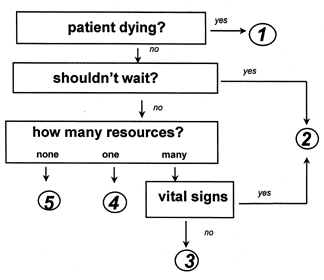Should you use a 5-level triage scale?
An elderly, immunocompromised patient with cancer presents to the ED with a fever and a heart rate of 110, referred by the local doctor for a "rule-out sepsis" Going by a three-level triage scale, the woman would be a Level Two, says Debbie Travers, RN, MSN, CEN, an ED triage nurse at University of North Carolina Hospitals in Chapel Hill. "But in fact, she may be a potentially very sick Level 2," she notes.
Under a new five-level system, this patient would be classified as "high-risk" and would be a Level Two, and she potentially would receive lifesaving care more quickly, says Travers. (See simplified version of five-level triage algorithm, below.)
5-Level Triage Algorithm |
Source: Copyright and licensed by David R. Eitel, MD, MBA, |
Nine EDs are using the scale
The Emergency Severity Index (ESI), developed by David Eitel, MD, MBA, an attending faculty in the emergency medicine residency program at York (PA) Hospital, and the late Richard Wuerz, MD, is a five-level triage scale used at nine EDs, including University of North Carolina Hospitals.
"This is a simple algorithm that helps you deal with increased volume and acuity and moving admitted patients out of the ED," says Nicki Gilboy, RN, MS, CEN, ED nurse educator at Brigham & Women’s Hospital in Boston, which also is using the new scale. "Accurate, rapid triage is critical to the smooth running of the ED," she stresses.
It’s vital to ensure the sickest patients are treated first in today’s busy EDs, says Travers. "The five-level triage scale provides the ED with a better tool for sorting patients by level of acuity than the three-level scale," she argues.
Prioritizing care is easier
Here are some benefits of the five-level scale:
• Triage is more specific. Previously, a large percentage of patients were grouped as Level Twos, but some were much sicker than others, says Travers. "Now, those middle patients are either Levels Two or Three, so we’re better able to prioritize their care," she explains.
With the five-level scale, the patients who were grouped in the middle are now prioritized as a Two, Three, or Four. "It’s much easier to figure out who to see next," says Travers. "A Level Two patient would be somebody with the worst headache of his or her life, or a chest pain patient who has had an MI before, but who won’t code in the next few minutes," she explains. Travers says that Level Twos are patients you are "pretty darn worried about" and Level Threes are individuals who are "sick, but can wait a little while.’"
• The scale is more consistent. Research has shown that three-level scales are not applied consistently by nurses, says Travers. "Other studies showed giving same nurses the same case studies of patients, and they didn’t rate the patients the same themselves," she says. "There is much better agreement with the five-level scale."1,2 With three-level scales, most patients end up in the middle as a Level Two, says Travers. "The top level used to be only if somebody was about to die, and most other patients got lumped in the middle or lower categories," she explains. "This wasn’t useful in prioritizing which patients you need to see next."
• Urgent care patients can be easily identified. Level Four and Five patients are seen in the urgent care center, says Travers. "This has really helped us differentiate the less sick and more sick patients, so it’s very easy for us to get a cutoff," Travers says. She adds that the five-level scale allows you to track the times when most Level Four and Five patients come in, so urgent care hours can be scheduled accordingly.
• You know what resources the patient will need. The levels also tell you what resources the patient probably will need, says Travers. "For example, if a patient comes in with a toothache, they will get a prescription and go home, but if they have a sore throat and a productive cough, they might get a chest X-ray or throat culture," she explains.
• Patients are less likely to be triaged at a lower level than appropriate. With a three-level triage system, patients can fall through the cracks in a busy ED, notes Gilboy. She gives an example of an immunosupressed patient with a fever. "With a five-level scale, that patient is a Level Two, which is clearly high-risk. But with a three-level scale, they could be classified as either emergent or urgent," says Gilboy. The nurse might be on the fence about deciding between emergent vs. urgent and choose the lower category, says Gilboy. "As a result, that patient can then end up waiting longer for care," she says.
References
1. Wuerz RC, Travers D, Gilboy N, et al. Implementation and refinement of the Emergency Severity Index. Acad Emerg Med 2001; 8:170-176.
2. Travers D, Waller A, Bowling JM, et al. Comparison of three-level and five-level triage acuity systems. J Emerg Nurs 2000; 26:411.
Sources
For more information about the five-level triage scale, contact:
• Nicki Gilboy, RN, MS, CEN, Emergency Department, Brigham & Women’s Hospital, 75 Francis St., Boston, MA 02115. Telephone: (617) 732-4824. Fax: (617) 278-6977. E-mail: Ngilboy@partners.org.
• Debbie Travers, RN, MSN, CEN, Emergency Department, University of North Carolina Hospitals, 101 Gravely Drive, Chapel Hill, NC 27516. Telephone: (919) 966-4721. Fax: (919) 966-3049. E-mail: dtravers@med.unc.edu.

